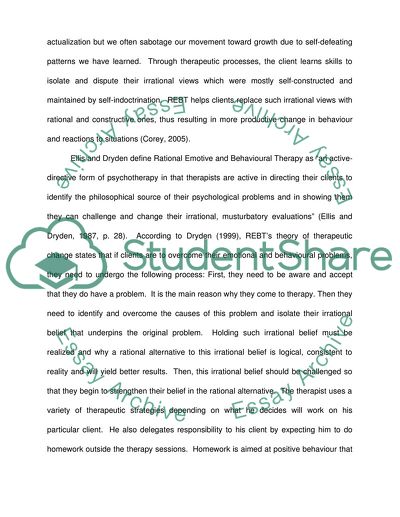Cite this document
(Rational Emotive Behavior Therapy Essay Example | Topics and Well Written Essays - 1750 words, n.d.)
Rational Emotive Behavior Therapy Essay Example | Topics and Well Written Essays - 1750 words. Retrieved from https://studentshare.org/social-science/1719985-provide-an-overview-of-the-three-main-stages-within-rational-emotive-and-cognitive-behaviournamely-beginning-stagemiddle-stageand-ending-stage-paying-particular-attention-to-the-role-of-the-counsellor-within-each-one
Rational Emotive Behavior Therapy Essay Example | Topics and Well Written Essays - 1750 words. Retrieved from https://studentshare.org/social-science/1719985-provide-an-overview-of-the-three-main-stages-within-rational-emotive-and-cognitive-behaviournamely-beginning-stagemiddle-stageand-ending-stage-paying-particular-attention-to-the-role-of-the-counsellor-within-each-one
(Rational Emotive Behavior Therapy Essay Example | Topics and Well Written Essays - 1750 Words)
Rational Emotive Behavior Therapy Essay Example | Topics and Well Written Essays - 1750 Words. https://studentshare.org/social-science/1719985-provide-an-overview-of-the-three-main-stages-within-rational-emotive-and-cognitive-behaviournamely-beginning-stagemiddle-stageand-ending-stage-paying-particular-attention-to-the-role-of-the-counsellor-within-each-one.
Rational Emotive Behavior Therapy Essay Example | Topics and Well Written Essays - 1750 Words. https://studentshare.org/social-science/1719985-provide-an-overview-of-the-three-main-stages-within-rational-emotive-and-cognitive-behaviournamely-beginning-stagemiddle-stageand-ending-stage-paying-particular-attention-to-the-role-of-the-counsellor-within-each-one.
“Rational Emotive Behavior Therapy Essay Example | Topics and Well Written Essays - 1750 Words”, n.d. https://studentshare.org/social-science/1719985-provide-an-overview-of-the-three-main-stages-within-rational-emotive-and-cognitive-behaviournamely-beginning-stagemiddle-stageand-ending-stage-paying-particular-attention-to-the-role-of-the-counsellor-within-each-one.


